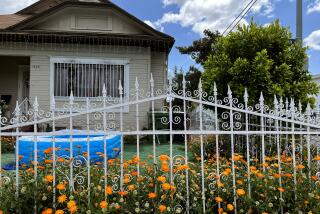The yard: so close, yet so far
STEPHEN COX once thought of his Van Nuys backyard as a private retreat for his family. “I was adamant we had to have a pool because I love the idea of sitting in a pool with a glass of wine or a beer. But the number of times I have done that I could count on one hand.”
Mary Deyden would like to hang out in her diamond-shaped backyard in Westchester. But with her three children competing in soccer, volleyball and basketball, “we’re always someplace else,” she says via cellphone from her car.
Cox and Deyden participated in a new study by UCLA, the first scholarly examination of how Los Angeles area families use the outdoor space around their homes. The findings show that neither parents nor their kids are enjoying much time of any sort, much less leisure, in their yards.
Anthropology professor Jeanne E. Arnold, lead author of the study that will be published in the March Journal of Family and Economic Issues, says that Angelenos put a lot of money into making their yards attractive and entertaining. “They are a buffer of green” from the outside world, she says, but “backyards might as well be blocks away considering how often the families go in them.”
Of the families with working parents and school-age children monitored for the study, more than half of the children didn’t spend any playtime in their backyards and most parents only wandered briefly there to perform chores: take out the trash, feed dogs or wash off chairs. “Occasionally a kid would kick a soccer ball but it wasn’t for too long,” says Arnold. “We admire backyards from inside the house or in our mind’s eye, while we’re busy doing other things.”
Cox, an events planner who works at home, never thought about how much he avoids his backyard until he heard the results of the study by the UCLA Center on the Everyday Lives of Families.
Sitting in his home office last week, Cox turns his back to a window with a view of the pool and an abandoned pingpong table. “We’re a sporty family,” says the father of twin 15-year-olds, “but no one goes out there. Our schedules are insane.”
He ventured into his sideyard only recently even though he had been curious about a new water heater that had been installed there 13 months ago.
“I saw that there are things I need to do there, like break up the old shed that housed the old water heater and pull weeds the gardeners don’t,” Cox says with a sigh. “I avoid my backyard because it just looks like work to me.”
Over the years, his backyard, likes others in the study, has slowly become a dumping ground for castoffs. Families are buying so much stuff that it ends up cluttering their homes, garages and yards.
Arnold says the trend of limited use of yards may be true for parents in a broad swath of two-earner families across the U.S., based on her close analysis of yards as well as other, larger leisure studies.
“It’s nice to know we’re not the only ones,” Cox says.
The outdoor-use study is one of dozens of studies to come out of UCLA’s multiyear, landmark research project, the first of its kind to rigorously examine middle-class, dual-income family life in Los Angeles. The project involved 32 families living in houses from 735 to 3,850 square feet and headed by two parents working full time, earning $59,000 to $500,000, enough money, Arnold states in her report, “to shape their indoor and outdoor spaces.”
The team of social scientists, educators and psychologists has collected data on space use, marital relations, child development, and recreational and socialization patterns and stress management. They took 20,000 photos, ones of each family’s house and possessions, drew up floor plans and spent four days tracking each family, night and day.
Parents and older children videotaped and narrated tours of their property, lasting from a few minutes to an hour. Some didn’t think to include the backyard. A few shot the backyard through a window. One mother’s voice is heard on a tape lamenting, “Relaxing time is back here, which seldom ever happens.”
Deyden, an office assistant, remembers playing in yards on her Huntington Beach street when she was growing up in the 1960s, and she wishes she could entice her children away from their indoor electronic games.
It seems so easy, she says, to serve a meal outside -- “my children would help me take it all back to the kitchen” -- and yet the opportunities slip away as schedules get tighter. “We’re spread out all the time,” she says.
Arnold says socializing in the frontyard is “a lost art” in Los Angeles except in a few communities. One family, identified in the study as Cuban Americans, read, talked and relaxed together daily on their front porch but ignored their backyard.
Yards front or back are convenient outlets to release stress, Arnold says.
“I wish people would think deeply about how we work hard to buy a lot of stuff we don’t need and then spend time maintaining it and we don’t take advantage of simple things like just taking a few minutes to relax in the backyard.”






